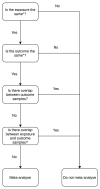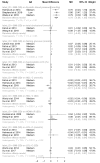Systematic review and meta-analyses: What has the application of Mendelian randomization told us about the causal effect of adiposity on health outcomes?
- PMID: 38974363
- PMCID: PMC11225060
- DOI: 10.12688/wellcomeopenres.18657.2
Systematic review and meta-analyses: What has the application of Mendelian randomization told us about the causal effect of adiposity on health outcomes?
Abstract
Mendelian randomization (MR) is increasingly used for generating estimates of the causal impact of exposures on outcomes. Evidence suggests a causal role of excess adipose tissue (adiposity) on many health outcomes. However, this body of work has not been systematically appraised. We systematically reviewed and meta-analysed results from MR studies investigating the association between adiposity and health outcomes prior to the SARS-CoV-2/COVID-19 pandemic (PROSPERO: CRD42018096684). We searched Medline, EMBASE, and bioRxiv up to February 2019 and obtained data on 2,214 MR analyses from 173 included articles. 29 meta-analyses were conducted using data from 34 articles (including 66 MR analyses) and results not able to be meta-analysed were narratively synthesised. Body mass index (BMI) was the predominant exposure used and was primarily associated with an increase in investigated outcomes; the largest effect in the meta-analyses was observed for the association between BMI and polycystic ovary syndrome (estimates reflect odds ratios (OR) per standard deviation change in each adiposity measure): OR = 2.55; 95% confidence interval (CI) = 1.22-5.33. Only colorectal cancer was investigated with two exposures in the meta-analysis: BMI (OR = 1.18; 95% CI = 1.01-1.37) and waist-hip ratio (WHR; OR = 1.48; 95% CI = 1.08-2.03). Broadly, results were consistent across the meta-analyses and narrative synthesis. Consistent with many observational studies, this work highlights the impact of adiposity across a broad spectrum of health outcomes, enabling targeted follow-up analyses. However, missing and incomplete data mean results should be interpreted with caution.
Keywords: Mendelian randomization; Systematic review; adiposity; epidemiology; obesity.
Copyright: © 2023 Lee MA et al.
Conflict of interest statement
No competing interests were disclosed.
Figures







References
Publication types
Grants and funding
LinkOut - more resources
Full Text Sources
Miscellaneous

